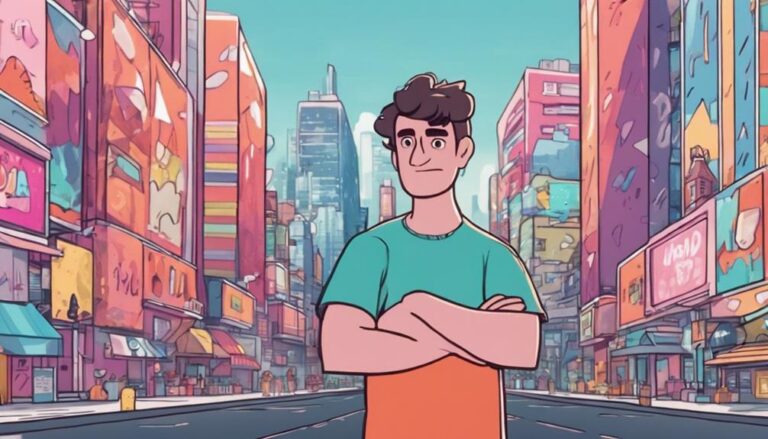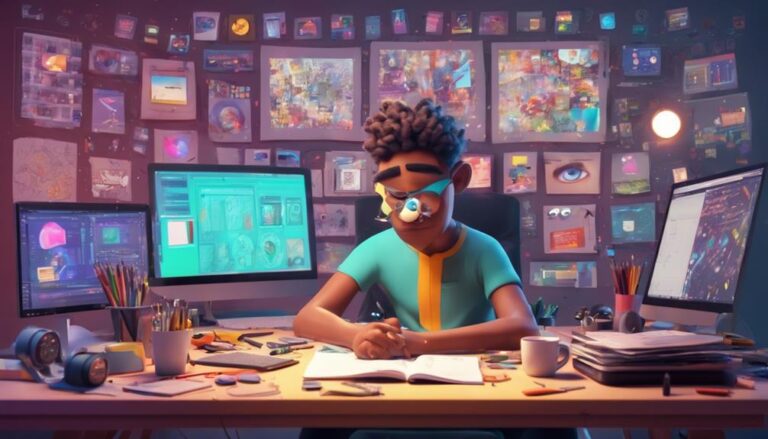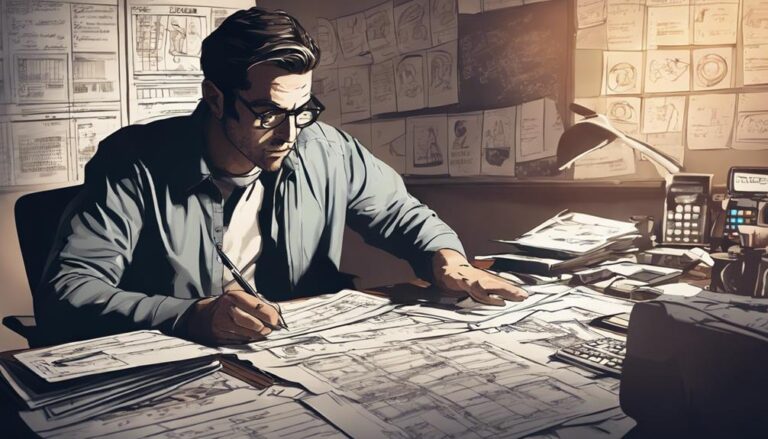How to Create 2D Animation for Beginners
You're about to reveal the secrets of bringing your imagination to life through 2D animation. Start by understanding the fundamentals: creating the illusion of movement, controlling viewer perception, and applying animation principles. Plan your project by defining its scope, brainstorming ideas, and identifying key elements. Choose the right software, considering factors like user-friendliness and features. Design engaging characters, create a storyboard blueprint, and bring your animation to life with smooth motion cycles. Add color, texture, and sound effects to make it pop. Finally, review and finalize your project. Now, take the next step and discover the details that'll make your animation shine.
Key Takeaways
- Start by planning your project, defining its scope and objectives, and brainstorming ideas to bring your vision to life.
- Choose the right 2D animation software for your project, considering factors like user-friendliness, features, and community support.
- Develop your characters by establishing strong design principles, creating a range of expressions, and building unique personalities.
- Create a storyboard to visually organize your animation's sequence of events, breaking down the script into individual scenes or shots.
- Practice the fundamental principles of animation, such as squash and stretch, anticipation, and staging, to create believable and engaging movements.
Understanding 2D Animation Basics
Mastering the fundamentals of 2D animation begins with grasping the concept of creating the illusion of movement by manipulating static images.
You'll learn to control the viewer's perception by breaking down movement into individual frames. This is where animation principles come in – understanding how to apply principles like squash and stretch, anticipation, and staging will help you create believable and engaging movements.
To bring your characters to life, you'll need to develop your styling techniques.
This includes deciding on the visual style, character design, and color palette that will define your animation. By combining these elements, you'll create a cohesive look that draws the viewer in.
As you refine your skills, you'll experiment with different styling techniques, from traditional hand-drawn methods to digital tools like Adobe Animate.
Planning Your Animation Project
With your styling techniques refined, you're now ready to bring your vision to life by planning your animation project, starting with defining its scope and objectives.
This is where you determine what your project is about, what you want to achieve, and who your target audience is. Take some time to brainstorm and jot down your ideas, no matter how rough they may seem.
What's your creative vision for this project? What message do you want to convey? What kind of story do you want to tell?
Next, define your project scope by identifying the key elements that will bring your vision to life.
What characters, settings, and props will you need? What's the estimated duration of your animation? What's your budget for this project?
Answering these questions will help you stay focused and guarantee that your project stays on track. Remember to keep your project scope realistic and achievable, especially if you're just starting out.
Choosing the Right Software
Now that you've planned your animation project, it's time to choose the right software to bring it to life.
You'll need to decide between free and paid tools, each with their own set of features and limitations.
Let's explore the different software options available to you, so you can select the one that best fits your needs and skill level.
Software Options Overview
You'll frequently find yourself spoiled for choice when it comes to 2D animation software, each offering a unique set of features and functionalities.
As a beginner, selecting the right software is vital to explore the different options available to find the one that suits your needs.
Open Canvas is a user-friendly software that's great for creating traditional hand-drawn animations. It offers a range of brush options, onion skinning, and a color management system.
Another option is Animation Toolkit, which focuses on cut-out animation and provides a library of pre-made characters and props. It's ideal for creating 2D animations with a puppet-like style.
Other software options include Toon Boom Harmony, Adobe Animate, and Pencil2D. Each of these software options has its strengths and weaknesses, and researching and experimenting with them is vital to find the one that works best for you.
Free Vs. Paid Tools
Deciding between free and paid tools is a crucial step in choosing the right software for your 2D animation project, as it ultimately affects your budget, workflow, and overall creative freedom.
You'll want to weigh your financial constraints, the level of complexity you're comfortable with, and the type of project you're working on.
If you're on a tight budget, free and open source alternatives like Blender, Pencil2D, or OpenToonz might be the way to go. These options offer a range of features and are often community-driven, which means there's a wealth of online resources available to help you get started.
However, be prepared to invest time in learning the software and troubleshooting any issues that arise.
If you're willing to invest in your project, paid tools like Adobe Animate, Toon Boom Harmony, or TVPaint Animation offer more advanced features and professional-level support.
Budget-friendly options like Clip Studio Paint or Animaker can provide a balance between cost and functionality.
Ultimately, the choice between free and paid tools depends on your specific needs and goals.
Take the time to research and compare your options before making a decision.
Designing Engaging Characters
Now that you've chosen the right software, it's time to bring your characters to life!
To create engaging characters, you'll need to establish strong design principles that make them visually appealing and relatable.
Character Design Principles
Develop a deep understanding of your character's personality, backstory, and motivations to craft an engaging and relatable persona that resonates with your audience. This foundation will help you make informed design decisions that bring your character to life.
Next, focus on body proportions. Verify your character's body is proportional to their age, genre, and style. For example, a cartoon character might've exaggerated features, while a realistic character would have more accurate proportions. Consider the character's occupation, lifestyle, and personality when designing their body shape, size, and stance.
Facial expressions are vital in conveying emotions and personality traits. Create a range of expressions that showcase your character's mood, from happy to sad, and from angry to surprised. Exaggerate facial features to make your character more relatable and engaging. Remember, consistency is key, so establish a style guide to certify your character's design remains cohesive throughout the animation.
Developing Unique Personalities
Developing Unique Personalities
To craft a truly memorable character, you must plunge beyond physical appearance and explore the intricacies of their personality, including their values, fears, and quirks. This is where you'll discover what makes them tick, what motivates them, and what sets them apart from others.
Start by identifying your character's core values, such as honesty, kindness, or ambition. These values will influence their decisions and actions throughout the story.
Next, consider their fears and insecurities, which can create relatable vulnerabilities and opportunities for growth.
Now, add some personality quirks to make your character more endearing and realistic. These can be mannerisms, habits, or speech patterns that are unique to them. For example, maybe they've a tendency to tap their foot when nervous or use colloquialisms in their dialogue.
As you develop these character traits, ask yourself questions like: What're their strengths and weaknesses? How do they interact with others? What're their goals and motivations? By answering these questions, you'll create a well-rounded character that audiences will love and remember.
Creating a Storyboard Blueprint
Create a fresh document or open a new page in your preferred drawing tool, dedicating it to your storyboard blueprint, where you'll visually organize your animation's sequence of events. This is where your storyboard evolution begins, and vital to get it right. Think of this blueprint as your visual script, outlining the pacing, camera angles, and character movements.
Start by breaking down your script into individual scenes or shots. Sketch a rough representation of each scene, including character poses, facial expressions, and any relevant props or backgrounds. Keep it simple – you're not aiming for perfection at this stage. Focus on capturing the essence of each scene and how it flows into the next.
As you continue to build your storyboard, you'll start to see your visual script take shape. You can experiment with different shot compositions, character interactions, and even try out alternative story paths. This is a pivotal part of the storyboard evolution process, where you refine your ideas and make adjustments before moving on to the next stage of production.
Setting Up Your Animation Scene
With your storyboard blueprint in hand, set up a new project in your preferred 2D animation software, carefully considering the resolution, frame rate, and color mode to guarantee your animation is optimized for its intended platform. You'll want to choose settings that align with the requirements of your target platform, such as HD resolution for YouTube or 4K for cinema.
Next, set up your scene layout by creating a new layer for each element, such as characters, backgrounds, and props. Organize your layers in a logical order, making it easy to navigate and edit your animation. Consider using a grid system to help you align and position your elements accurately.
Within your scene, create a new layer for your character's rig, which will hold the individual body parts and limbs. This will make it easier to animate and manipulate your character's movements. Finally, save your project frequently as you work to avoid losing any progress.
Creating Smooth Motion Cycles
Now that you've set up your animation scene, it's time to focus on creating smooth motion cycles.
You'll start by designing keyframe poses that capture the essence of your character's movement, and then refine those poses by adjusting the motion curves.
Designing Keyframe Poses
Designing Keyframe Poses
To design keyframe poses that result in smooth motion cycles, you'll need to focus on capturing the most essential movements and poses of your character or object. This involves breaking down the action into its most critical components, ensuring that each keyframe pose conveys the intended emotion and movement.
Start by creating pose variations that showcase different emotional expressions. For example, if your character is jumping for joy, you might create keyframe poses that capture the excitement and elation on their face. Next, experiment with different body language and posture to convey the emotional state of your character. Remember, the goal is to create a clear and cohesive visual language that communicates the story and emotion effectively.
When designing keyframe poses, keep it simple and focus on the essentials. Avoid cluttering your scene with unnecessary details, and instead, prioritize the key elements that drive the action and emotion forward. By doing so, you'll be able to create smooth motion cycles that engage your audience and bring your story to life.
Refining Motion Curves
You've established a solid foundation with your keyframe poses, and now it's time to bring them to life by refining the motion curves that connect these poses, ensuring a seamless and believable flow of movement.
To achieve this, focus on motion precision by adjusting the curve's shape and timing. Start by selecting a curve and examining its nuances, paying attention to the acceleration and deceleration of the motion.
Ask yourself: Does the motion feel natural and fluid, or does it jerk or stutter?
Make adjustments to the curve's tension, bias, and continuity to achieve the desired effect.
You can also try using the 'easy ease' feature to create a more organic feel.
Adding Color and Texture Depth
Add depth and visual interest to your 2D animation by introducing a range of colors and textures that enhance the mood and atmosphere of your scene.
To get started, create a color script, which is a visual representation of the color palette for each scene. This will help you plan and organize your colors, ensuring consistency throughout your animation.
Next, create texture maps to add depth and dimension to your characters and backgrounds. Texture maps are 2D images that mimic the texture of real-world materials, such as wood, fabric, or stone. You can create your own texture maps or use pre-made ones.
When applying textures, consider the type of material, the lighting, and the mood you want to convey.
As you add colors and textures, remember to balance and harmonize them to create a cohesive look. Experiment with different combinations to find the perfect fit for your animation.
Finally, don't be afraid to adjust and refine your colors and textures as you see your animation come to life.
With these steps, you'll be well on your way to creating a visually stunning 2D animation that captivates your audience.
Adding Sound and Music Effects
Bring your 2D animation to life by incorporating sound and music effects that enhance the mood, atmosphere, and emotional impact of your scene.
To start, identify the key moments in your animation that require sound effects, such as character movements or environmental sounds. Then, create a sound design plan, deciding on the type of sounds you need and where to source them. You can either create your own sounds or use royalty-free sound effects from online libraries.
Next, consider adding music to your animation. Music licensing can be complex, so make sure you understand the terms and conditions of using a particular track.
You can opt for royalty-free music or commission a composer to create an original score. When selecting music, choose a track that complements your animation's tone and pace.
Import your sound effects and music into your animation software, and adjust the levels and timing to guarantee a seamless integration.
Finalizing Your Animation Project
With your animation's sound design and music in place, the final touches are now within reach, and it's time to refine every detail to guarantee a polished and professional finish.
Before considering your project complete, make sure to do the following final checks:
Review your animation's pacing: Certify your animation flows smoothly, and the timing of each scene is perfect.
Check for errors: Look for any mistakes, such as typos, inconsistencies, or technical issues.
Maintain consistency: Verify that your animation's style, tone, and quality are consistent throughout.
Get feedback: Show your animation to others and ask for constructive feedback to identify areas for improvement.
Once you've completed these final checks, you're ready to showcase your project to the world!
Prepare to share your animation on social media, animation platforms, or even film festivals.
Be proud of your hard work, and get ready to receive feedback and accolades from your audience.
Frequently Asked Questions
Can I Use a Drawing Tablet Instead of a Mouse?
You can definitely use a drawing tablet instead of a mouse! In fact, it'll improve your drawing accuracy and comfort, thanks to better tablet ergonomics, allowing you to focus on creating amazing animations.
How Do I Protect My Animation From Being Stolen Online?
You'll want to protect your animation from being stolen online by adding visible or invisible watermarks, registering your work with the copyright office, and using licenses that outline usage terms to safeguard your creative property.
What Is the Ideal Resolution for 2D Animation?
When setting your animation's resolution, you'll want to weigh pixel density and screen dimensions. Typically, aim for 1080p (1920×1080) or 4K (3840×2160) for high-quality visuals, but adjust based on your target platform's requirements.
Can I Use Royalty-Free Music in My Animation?
You can use royalty-free music in your animation, but make sure to check the music licensing terms and copyright laws to avoid any legal issues, and always give credit to the original creator.
Do I Need to Know How to Draw to Create 2D Animation?
You don't need to be a skilled artist to create 2D animation, but having some artistic skills can enhance your creative freedom.
Conclusion
You've made it! You now have a solid understanding of the basics of 2D animation and a complete project under your belt.
Pat yourself on the back – you've earned it! From planning to finalizing, you've navigated the entire process.
Your characters come to life, your story unfolds, and your animation is ready to captivate audiences.
Take pride in your accomplishment and keep practicing – the world of 2D animation is full of endless possibilities waiting for you to explore.




